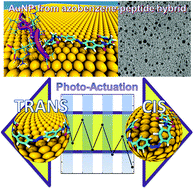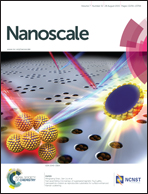Triggering nanoparticle surface ligand rearrangement via external stimuli: light-based actuation of biointerfaces†
Abstract
Bio-molecular non-covalent interactions provide a powerful platform for material-specific self-organization in aqueous media. Here, we introduce a strategy that integrates a synthetic optically-responsive motif with a materials-binding peptide to enable remote actuation. Specifically, we linked a photoswitchable azobenzene moiety to either terminus of a Au-binding peptide. We employed these hybrid molecules as capping agents for synthesis of Au nanoparticles. Integrated experiments and molecular simulations showed that the hybrid molecules maintained both of their functions, i.e. binding to Au and optically-triggered reconfiguration. The azobenzene unit was optically switched reversibly between trans and cis states while adsorbed on the particle surface. Upon switching, the conformation of the peptide component of the molecule also changed. This highlights the interplay between the surface adsorption and conformational switching that will be pivotal to the creation of actuatable nanoparticle bio-interfaces, and paves the way toward multifunctional peptide hybrids that can produce stimuli responsive nanoassemblies.


 Please wait while we load your content...
Please wait while we load your content...